USSR plans next-generation space station
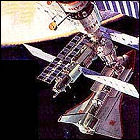 With work having started mere days earlier on Buran, a Soviet version of the American space shuttle design, the Soviet Union’s space agency is given new marching orders to create a new generation of space station hardware, based on the experience gained thus far with the four Salyut space stations and their associated Almaz military space hardware. A modular design is chosen, with multiple docking ports and multiple station components launched over a period of time, concepts which will be tested with yet-to-be-launched Salyut stations. Frequently fighting with the Buran shuttle development program for money and resources (despite the fact that the two spacecraft are expected to be compatible), this new station will not be launched until 1986, almost exactly ten years later, at which time it will be known as Mir.
With work having started mere days earlier on Buran, a Soviet version of the American space shuttle design, the Soviet Union’s space agency is given new marching orders to create a new generation of space station hardware, based on the experience gained thus far with the four Salyut space stations and their associated Almaz military space hardware. A modular design is chosen, with multiple docking ports and multiple station components launched over a period of time, concepts which will be tested with yet-to-be-launched Salyut stations. Frequently fighting with the Buran shuttle development program for money and resources (despite the fact that the two spacecraft are expected to be compatible), this new station will not be launched until 1986, almost exactly ten years later, at which time it will be known as Mir.

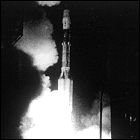 The Soviet Union launches the first module of its new Mir space station, a new modular station design building on the Soviets’ years of experience with the Salyut stations. One end of this “core” module is a six-sided structure, with docking ports on five sides; this design will allow new modules to be added onto Mir in all directions, and will potentially allow for several Soyuz or unmanned Progress cargo vehicles to be docked simultaneously, a design element which will later be carried forward to the International Space Station.
The Soviet Union launches the first module of its new Mir space station, a new modular station design building on the Soviets’ years of experience with the Salyut stations. One end of this “core” module is a six-sided structure, with docking ports on five sides; this design will allow new modules to be added onto Mir in all directions, and will potentially allow for several Soyuz or unmanned Progress cargo vehicles to be docked simultaneously, a design element which will later be carried forward to the International Space Station.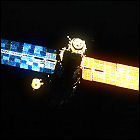 The Soviet Union launches Soyuz T-15 on an unprecedented mission into orbit. Cosmonauts Leonid Kizim and Vladimir Solovyov become the first occupants of the newly-launched Mir space station on March 15th, where they remain until early May, at which time they undock the Soyuz T-15 vehicle from Mir and visit the powered-down Salyut 7 space station, becoming its final occupants until they return to Mir in late June, bringing several pieces of equipment and experiments cannibalized from Salyut back with them. The crew spends a total of 125 days in space, at the end of which Kizim is the most-traveled man in space, having accumulated over a year of total space travel time. Soyut T-15 is the last second-generation Soyuz vehicle to fly, returning to Earth on July 16th.
The Soviet Union launches Soyuz T-15 on an unprecedented mission into orbit. Cosmonauts Leonid Kizim and Vladimir Solovyov become the first occupants of the newly-launched Mir space station on March 15th, where they remain until early May, at which time they undock the Soyuz T-15 vehicle from Mir and visit the powered-down Salyut 7 space station, becoming its final occupants until they return to Mir in late June, bringing several pieces of equipment and experiments cannibalized from Salyut back with them. The crew spends a total of 125 days in space, at the end of which Kizim is the most-traveled man in space, having accumulated over a year of total space travel time. Soyut T-15 is the last second-generation Soyuz vehicle to fly, returning to Earth on July 16th.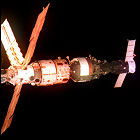 The Soviet Union launches Soyuz TM-2, the first manned launch of a newly uprated version of the Soyuz capsule. Cosmonauts Yuri Romanenko and Aleksandr Laveykin travel to the Mir space station, where Laveykin remains for 174 days before departing in July, but Romanenko sets a new space endurance record, remaining in orbit for 326 days. Romanenko’s return to Earth just before the end of 1987 marks the end of Expedition 2’s occupancy of Mir.
The Soviet Union launches Soyuz TM-2, the first manned launch of a newly uprated version of the Soyuz capsule. Cosmonauts Yuri Romanenko and Aleksandr Laveykin travel to the Mir space station, where Laveykin remains for 174 days before departing in July, but Romanenko sets a new space endurance record, remaining in orbit for 326 days. Romanenko’s return to Earth just before the end of 1987 marks the end of Expedition 2’s occupancy of Mir.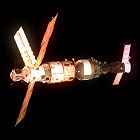 The Soviet Union launches Soyuz TM-3 on an eight-day mission into space which includes a visit to space station Mir. Cosmonauts Aleksandr Aleksandrov and Muhammed Faris (the latter of whom is the first Syrian space traveler) return to Earth at the end of the mission, along with Mir crew member Yuri Romanenko, while Alexander Viktorenko takes Romanenko’s slot on Mir. In order to leave the newer vehicle docked to Mir as an escape craft, the Soyuz TM-3 crew returns aboard Soyuz TM-2.
The Soviet Union launches Soyuz TM-3 on an eight-day mission into space which includes a visit to space station Mir. Cosmonauts Aleksandr Aleksandrov and Muhammed Faris (the latter of whom is the first Syrian space traveler) return to Earth at the end of the mission, along with Mir crew member Yuri Romanenko, while Alexander Viktorenko takes Romanenko’s slot on Mir. In order to leave the newer vehicle docked to Mir as an escape craft, the Soyuz TM-3 crew returns aboard Soyuz TM-2.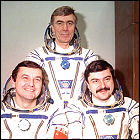 The Soyuz TM-4 mission is launched by the Soviet Union, en route to space station Mir. Cosmonauts Vladimir Titov and Musa Manarov take up residence as the new long-duration crew aboard Mir, formally known as Expedition 3, and they eventually break all previous space endurance records by staying aboard Mir for exactly one year and one day, returning to Earth on December 21st, 1988. Cosmonaut Anatoli Levchenko, after the week-long overlap with the Expedition 2 crew, returns to Earth with Expedition 2 crew members Yuri Romanenko and Aleksandr Aleksandrov aboard the Soyuz TM-3 vehicle.
The Soyuz TM-4 mission is launched by the Soviet Union, en route to space station Mir. Cosmonauts Vladimir Titov and Musa Manarov take up residence as the new long-duration crew aboard Mir, formally known as Expedition 3, and they eventually break all previous space endurance records by staying aboard Mir for exactly one year and one day, returning to Earth on December 21st, 1988. Cosmonaut Anatoli Levchenko, after the week-long overlap with the Expedition 2 crew, returns to Earth with Expedition 2 crew members Yuri Romanenko and Aleksandr Aleksandrov aboard the Soyuz TM-3 vehicle.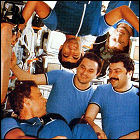 Cosmonauts Anatoly Solovyev, Viktor Savinykh and Aleksandr Aleksandrov lift off for a week-long visit to Soviet space station Mir aboard Soyuz TM-5. Numerous biological and astronomical experiments are conducted by the blended crew, and at the end of the week of joint activities, the Soyuz TM-5 crew use the older TM-4 capsule to return home, leaving the station crew with a newer vehicle.
Cosmonauts Anatoly Solovyev, Viktor Savinykh and Aleksandr Aleksandrov lift off for a week-long visit to Soviet space station Mir aboard Soyuz TM-5. Numerous biological and astronomical experiments are conducted by the blended crew, and at the end of the week of joint activities, the Soyuz TM-5 crew use the older TM-4 capsule to return home, leaving the station crew with a newer vehicle.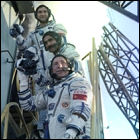 The Soviet Union launches the Soyuz TM-6 mission to the Mir space station, with cosmonauts Vladimir Lyakhov, Valeri Polyakov and Abdul Ahad Mohmand aboard. Lyakhov and Mohmand remain aboard Mir for only a week, participating in experiments involving both crews, but Polyakov, a medical doctor, remains on Mir to monitor the Expedition 3 crew in the final months of their unprecedented one-year stay in orbit. This crew exchanges spacecraft with the station crew, returning home in the Soyuz TM-5 vehicle after a week on Mir, but their return is plagued by problems both technical and otherwise.
The Soviet Union launches the Soyuz TM-6 mission to the Mir space station, with cosmonauts Vladimir Lyakhov, Valeri Polyakov and Abdul Ahad Mohmand aboard. Lyakhov and Mohmand remain aboard Mir for only a week, participating in experiments involving both crews, but Polyakov, a medical doctor, remains on Mir to monitor the Expedition 3 crew in the final months of their unprecedented one-year stay in orbit. This crew exchanges spacecraft with the station crew, returning home in the Soyuz TM-5 vehicle after a week on Mir, but their return is plagued by problems both technical and otherwise.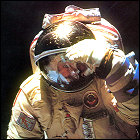 The Soviet Union launches Soyuz TM-7 to space station Mir, ferrying cosmonauts Alexander Volkov and Sergei Krikalev, and French spationaut Jean-Loup Chrétien to the station. Volkov and Krikalev will remain aboard Mir for 151 days, while Chrétien will remain for a shorter 24-day mission. Chrétien had visited the Salyut 7 space station on his previous spaceflight; his next flight, in 1997, will visit Mir again, this time by way of Space Shuttle Atlantis. Unusually, the return of this Mir crew will leave the station unoccupied for almost half a year.
The Soviet Union launches Soyuz TM-7 to space station Mir, ferrying cosmonauts Alexander Volkov and Sergei Krikalev, and French spationaut Jean-Loup Chrétien to the station. Volkov and Krikalev will remain aboard Mir for 151 days, while Chrétien will remain for a shorter 24-day mission. Chrétien had visited the Salyut 7 space station on his previous spaceflight; his next flight, in 1997, will visit Mir again, this time by way of Space Shuttle Atlantis. Unusually, the return of this Mir crew will leave the station unoccupied for almost half a year.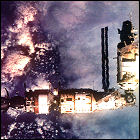 Cosmonauts Alexander Viktorenko and Aleksandr Serebrov lift off aboard the Soviet spacecraft Soyuz TM-8, bound for the presently unoccupied space station Mir (which had been left without a crew since April 1989). At a distance of only 4 meters to Mir’s docking hatch, Soyuz TM-8 suffers a breakdown of its automated docking system, and Viktorenko has no choice but to back the Soyuz away and carefully dock under manual control. The two-man crew remains aboard Mir for 166 days, returning to Earth in February 1990.
Cosmonauts Alexander Viktorenko and Aleksandr Serebrov lift off aboard the Soviet spacecraft Soyuz TM-8, bound for the presently unoccupied space station Mir (which had been left without a crew since April 1989). At a distance of only 4 meters to Mir’s docking hatch, Soyuz TM-8 suffers a breakdown of its automated docking system, and Viktorenko has no choice but to back the Soyuz away and carefully dock under manual control. The two-man crew remains aboard Mir for 166 days, returning to Earth in February 1990.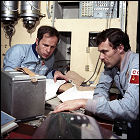 Cosmonauts Anatoly Solovyev
Cosmonauts Anatoly Solovyev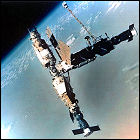 The Soviet Union launches the Kristall module, whose pre-programmed systems bring it to the Mir space station for an automated docking. With facilities for material science experiments, additional gyroscopic stabilizers to keep Mir properly oriented, and other equipment, Kristall also features an extended docking port intended to allow the Soviet-made Buran shuttle to dock at Mir. In time, that docking port will allow a space shuttle to berth at Mir… but not the one its designers anticipate.
The Soviet Union launches the Kristall module, whose pre-programmed systems bring it to the Mir space station for an automated docking. With facilities for material science experiments, additional gyroscopic stabilizers to keep Mir properly oriented, and other equipment, Kristall also features an extended docking port intended to allow the Soviet-made Buran shuttle to dock at Mir. In time, that docking port will allow a space shuttle to berth at Mir… but not the one its designers anticipate.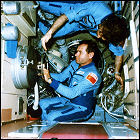 The Soviet Union launches Soyuz TM-10, carrying cosmonauts Gennadi Manakov and Gennady Strekalov to space station Mir for a long-duration stay in orbit. After a 130-day stay aboard Mir, the TM-10 crew returns, bringing with them Japanese TV reporter Toyohiro Akiyama, who would arrive aboard Mir via Soyuz TM-11 in December. Strekalov will return to serve another tour aboard Mir in the 1990s, becoming the first Russian cosmonaut to arrive in a Soyuz and return home in an American space shuttle.
The Soviet Union launches Soyuz TM-10, carrying cosmonauts Gennadi Manakov and Gennady Strekalov to space station Mir for a long-duration stay in orbit. After a 130-day stay aboard Mir, the TM-10 crew returns, bringing with them Japanese TV reporter Toyohiro Akiyama, who would arrive aboard Mir via Soyuz TM-11 in December. Strekalov will return to serve another tour aboard Mir in the 1990s, becoming the first Russian cosmonaut to arrive in a Soyuz and return home in an American space shuttle.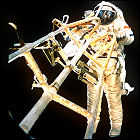 Soyuz TM-11 lifts off from the Baikonur Cosmodrome in the Soviet Union, bound for the space station Mir. Aboard the Soyuz is a crew of three: cosmonauts Viktor Afanasyev and Musa Manarov, with Tokyo Broadcasting System reporter Toyohiro Akiyama, who transmits live reports from Mir for the duration of his week in orbit. (Akiyama will return to Earth with the Soyuz TM-10 crew.) Akiyama is the first space traveler whose seat has been commercially bought and paid for, a flight which ignites the “space tourism” industry built around buying Soyuz seats. Afanasyev and Manarov remain in orbit for 175 days, returning to Earth with British space traveler Helen Sharman in May 1991.
Soyuz TM-11 lifts off from the Baikonur Cosmodrome in the Soviet Union, bound for the space station Mir. Aboard the Soyuz is a crew of three: cosmonauts Viktor Afanasyev and Musa Manarov, with Tokyo Broadcasting System reporter Toyohiro Akiyama, who transmits live reports from Mir for the duration of his week in orbit. (Akiyama will return to Earth with the Soyuz TM-10 crew.) Akiyama is the first space traveler whose seat has been commercially bought and paid for, a flight which ignites the “space tourism” industry built around buying Soyuz seats. Afanasyev and Manarov remain in orbit for 175 days, returning to Earth with British space traveler Helen Sharman in May 1991.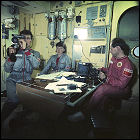 Helen Sharman becomes the first British national in space, flying aboard Soyuz TM-12 to the Soviet space station Mir. Making her flight in a seat bought and paid for by a consortium of British commercial interests, Sharman tags along with cosmonauts Anatoly Artsebarsky and Sergei Krikalev, and she spends just a week in orbit before returning with Soyuz TM-13 cosmonaut Toktar Aubakirov. Artsebarsky and Krikalev remain aboard Mir for what is initially planned to be a five-month stay, though a shake-up in the flight schedule forces mission planners to ask Krikalev to stay aboard Mir even after Artsebarsky returns to Earth, resulting in Krikalev remaining on Mir for 10 months, not returning home until 1992 – at which point the Soviet Union will have ceased to exist.
Helen Sharman becomes the first British national in space, flying aboard Soyuz TM-12 to the Soviet space station Mir. Making her flight in a seat bought and paid for by a consortium of British commercial interests, Sharman tags along with cosmonauts Anatoly Artsebarsky and Sergei Krikalev, and she spends just a week in orbit before returning with Soyuz TM-13 cosmonaut Toktar Aubakirov. Artsebarsky and Krikalev remain aboard Mir for what is initially planned to be a five-month stay, though a shake-up in the flight schedule forces mission planners to ask Krikalev to stay aboard Mir even after Artsebarsky returns to Earth, resulting in Krikalev remaining on Mir for 10 months, not returning home until 1992 – at which point the Soviet Union will have ceased to exist.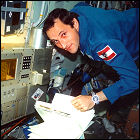 The Soviet Union launches its last space mission, Soyuz TM-13, carrying cosmonauts Alexander Volkov, Toktar Aubakirov and the first Austrian in space, Franz Viehböck, to space station Mir. After a week in space, Aubakirov and Viehböck return to Earth aboard Soyuz TM-12 with incumbent station crewmember Anatoly Artsebarksky, while Volkov stays for 175 days (alongside Krikalev, who will have been in space for 10 months by the time he returns to Earth in 1992). During Volkov and Krikalev’s stay aboard Mir, the Soviet Union collapses; they instead return to Earth as Russian citizens.
The Soviet Union launches its last space mission, Soyuz TM-13, carrying cosmonauts Alexander Volkov, Toktar Aubakirov and the first Austrian in space, Franz Viehböck, to space station Mir. After a week in space, Aubakirov and Viehböck return to Earth aboard Soyuz TM-12 with incumbent station crewmember Anatoly Artsebarksky, while Volkov stays for 175 days (alongside Krikalev, who will have been in space for 10 months by the time he returns to Earth in 1992). During Volkov and Krikalev’s stay aboard Mir, the Soviet Union collapses; they instead return to Earth as Russian citizens.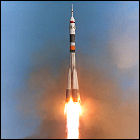 Soyuz TM-14 lifts off from the Baikonur Cosmodrome in Kazakhstan, the first space mission from post-Soviet Russia. It carries cosmonauts Alexander Viktorenko, Alexander Kaleri, and Klaus-Dietrich Flade to space station Mir. Viktorenko and Kaleri remain aboard Mir for 145 days, while Flade returns to Earth with the previous station crew aboard Soyuz TM-13. When TM-14 returns to Earth in August 1992, Viktorenko and Kaleri suffer an unusual landing, with their descent module rolling to an upside-down position, trapping the cosmonauts inside until rescue crews arrive.
Soyuz TM-14 lifts off from the Baikonur Cosmodrome in Kazakhstan, the first space mission from post-Soviet Russia. It carries cosmonauts Alexander Viktorenko, Alexander Kaleri, and Klaus-Dietrich Flade to space station Mir. Viktorenko and Kaleri remain aboard Mir for 145 days, while Flade returns to Earth with the previous station crew aboard Soyuz TM-13. When TM-14 returns to Earth in August 1992, Viktorenko and Kaleri suffer an unusual landing, with their descent module rolling to an upside-down position, trapping the cosmonauts inside until rescue crews arrive.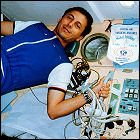 The Russian spacecraft Soyuz TM-15 lifts off from Kazakhstan, carrying cosmonauts Anatoly Solovyev and Sergei Avdeyev, along with French spationaut Michel Tognini, to space station Mir. Tognini remains aboard Mir for two weeks, returning with the Soyuz TM-14 crew, while Solovyev and Avdeyev are aboard for the long haul, manning Mir for 188 days before returning to Earth early in 1993.
The Russian spacecraft Soyuz TM-15 lifts off from Kazakhstan, carrying cosmonauts Anatoly Solovyev and Sergei Avdeyev, along with French spationaut Michel Tognini, to space station Mir. Tognini remains aboard Mir for two weeks, returning with the Soyuz TM-14 crew, while Solovyev and Avdeyev are aboard for the long haul, manning Mir for 188 days before returning to Earth early in 1993.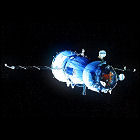 Cosmonauts Gennadi Manakov and Alexander Poleshchuk lift off aboard Soyuz TM-16, on a course for Russian space station Mir. In preparation for the upcoming joint international missions that will see American space shuttles docking with Mir, Soyuz TM-16 carries a new type of docking mechanism designed to test the docking port that will be used by visiting shuttles. Manakov and Poleshchuk remain aboard Mir for 179 days, returning to Earth in July 1993 with French spationaut Jean-Pierre Haigneré.
Cosmonauts Gennadi Manakov and Alexander Poleshchuk lift off aboard Soyuz TM-16, on a course for Russian space station Mir. In preparation for the upcoming joint international missions that will see American space shuttles docking with Mir, Soyuz TM-16 carries a new type of docking mechanism designed to test the docking port that will be used by visiting shuttles. Manakov and Poleshchuk remain aboard Mir for 179 days, returning to Earth in July 1993 with French spationaut Jean-Pierre Haigneré.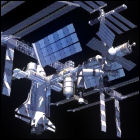 Having drawn the European Space Agency and Japan into partnerships for the still-on-the-drawing-board Space Station Freedom project, NASA announces that it is reaching out to post-Soviet Russia, not just for ideas and engineering expertise, but to become partners in the new space station. With already-built modules sitting on the ground for a Mir 2 station that it cannot afford to launch and operate on its own, Russia becomes a full partner in what will now become the International Space Station. Plans are accelerated for proposed missions to dock the Space Shuttle to the existing Mir space station, and to use Russian Soyuz capsules for crew transfer and return.
Having drawn the European Space Agency and Japan into partnerships for the still-on-the-drawing-board Space Station Freedom project, NASA announces that it is reaching out to post-Soviet Russia, not just for ideas and engineering expertise, but to become partners in the new space station. With already-built modules sitting on the ground for a Mir 2 station that it cannot afford to launch and operate on its own, Russia becomes a full partner in what will now become the International Space Station. Plans are accelerated for proposed missions to dock the Space Shuttle to the existing Mir space station, and to use Russian Soyuz capsules for crew transfer and return.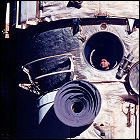 Russian spacecraft Soyuz TM-18 lifts off from Baikonur Cosmodrome in Kazakhstan, on a mission to the Russian space station Mir. Aboard the Soyuz are cosmonauts Viktor Afanasyev, Yuri Usachov, and Dr. Valeri Polyakov, a medical doctor who will study the effects of long-duration spaceflight on the crew (including himself). Following a scary close call with the previous crew’s wayward Soyuz, the TM-18 crew settles in for a 182-day stay, with Afanasyev and Usachov returning to Earth; Polyakov remains aboard Mir, where he will eventually set the human space endurance record with a 420-day stay in orbit.
Russian spacecraft Soyuz TM-18 lifts off from Baikonur Cosmodrome in Kazakhstan, on a mission to the Russian space station Mir. Aboard the Soyuz are cosmonauts Viktor Afanasyev, Yuri Usachov, and Dr. Valeri Polyakov, a medical doctor who will study the effects of long-duration spaceflight on the crew (including himself). Following a scary close call with the previous crew’s wayward Soyuz, the TM-18 crew settles in for a 182-day stay, with Afanasyev and Usachov returning to Earth; Polyakov remains aboard Mir, where he will eventually set the human space endurance record with a 420-day stay in orbit.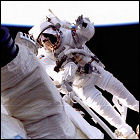 Soyuz TM-19 lifts off from Kazakhstan, on a mission to the Russian space station Mir with cosmonauts Yuri Malenchenko and Talgat Musabayev aboard. Over the course of their 125-day stay, the crew joins Dr. Valery Polyakov aboard Mir, in the middle of his record-shattering 437-day stay in space. Malenchenko and Musabayev conduct 11 hours worth of spacewalks to repair Mir’s exterior insulation and other minor maintenance, and returns home in November 1994 with German astronaut Ulf Merbold.
Soyuz TM-19 lifts off from Kazakhstan, on a mission to the Russian space station Mir with cosmonauts Yuri Malenchenko and Talgat Musabayev aboard. Over the course of their 125-day stay, the crew joins Dr. Valery Polyakov aboard Mir, in the middle of his record-shattering 437-day stay in space. Malenchenko and Musabayev conduct 11 hours worth of spacewalks to repair Mir’s exterior insulation and other minor maintenance, and returns home in November 1994 with German astronaut Ulf Merbold.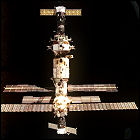 Russia launches the Soyuz TM-20 mission to space station Mir, carrying cosmonauts Alexander Viktorenko and Yelena Kondakova, and German astronaut Ulf Merbold, who will remain for only a month to conduct experiments in orbit. A glitch in the automated docking system forces Viktorenko to assume manual control for the docking with Mir, a problem which will plague future Mir crews. Viktorenko and Kondakova remain aboard Mir for 169 days, returning to Earth in March 1995 with the new space endurance world record holder, Dr. Valery Polyakov, who has spent 437 days in orbit.
Russia launches the Soyuz TM-20 mission to space station Mir, carrying cosmonauts Alexander Viktorenko and Yelena Kondakova, and German astronaut Ulf Merbold, who will remain for only a month to conduct experiments in orbit. A glitch in the automated docking system forces Viktorenko to assume manual control for the docking with Mir, a problem which will plague future Mir crews. Viktorenko and Kondakova remain aboard Mir for 169 days, returning to Earth in March 1995 with the new space endurance world record holder, Dr. Valery Polyakov, who has spent 437 days in orbit.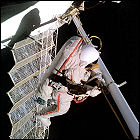 An American astronaut lifts off aboard a Russian Soyuz spacecraft for the first time ever with the launch of Soyuz TM-21, a mission to the Mir space station. Cosmonauts Vladimir Dezhurov and Gennady Strekalov are joined by astronaut Norman Thagard aboard Mir, where they remain for 115 days. During that time, they witness the arrival of the Spektr module, a new addition to the station, and they ultimately return to Earth aboard space shuttle Atlantis in July 1995; Soyuz TM-21 remains at the station, where a future Mir crew uses it to return to Earth. During the Atlantis mission, a new record is set for the number of humans in space, as the station and shuttle crews add up to 13 people in orbit at once.
An American astronaut lifts off aboard a Russian Soyuz spacecraft for the first time ever with the launch of Soyuz TM-21, a mission to the Mir space station. Cosmonauts Vladimir Dezhurov and Gennady Strekalov are joined by astronaut Norman Thagard aboard Mir, where they remain for 115 days. During that time, they witness the arrival of the Spektr module, a new addition to the station, and they ultimately return to Earth aboard space shuttle Atlantis in July 1995; Soyuz TM-21 remains at the station, where a future Mir crew uses it to return to Earth. During the Atlantis mission, a new record is set for the number of humans in space, as the station and shuttle crews add up to 13 people in orbit at once.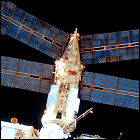 For the first time in five years, and the first time under the auspices of the Russian Federation, a new module is launched to expand the Mir space station. Originally devised as an add-on compartment to house experiments and equipment of a military nature, the Spektr module is, somewhat ironically, refitted to house American astronauts who will be joining future Mir station crews. Spektr also doubles Mir’s power generating capacity with its own solar panels.
For the first time in five years, and the first time under the auspices of the Russian Federation, a new module is launched to expand the Mir space station. Originally devised as an add-on compartment to house experiments and equipment of a military nature, the Spektr module is, somewhat ironically, refitted to house American astronauts who will be joining future Mir station crews. Spektr also doubles Mir’s power generating capacity with its own solar panels.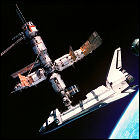 Space Shuttle Atlantis lifts off on an almost-ten-day mission to dock with the Russian space station Mir. The first docking proves to be a chore, as the Mir crew has to move one of the station’s modules to a different docking port to accomodate the shuttle. The historic docking – the first joint operation between the two countries since the Apollo-Soyuz mission almost exactly 20 years earlier – results in the largest man-made object in space to date. Aboard Atlantis are Commander Robert Gibson, Pilot Charles Precourt, and mission specialists Ellen Baker, Bonnie Dunbar and Gregory Harbaugh; cosmonauts Anatoly Solovyev and Nikolai Budarin are transported to Mir aboard Atlantis to become part of Mir Expedition 19, while Expedition 18 crew members Norman Thagard, Vladimir Dezhurov and Gannady Strekalov return to Earth after more than three months aboard Mir.
Space Shuttle Atlantis lifts off on an almost-ten-day mission to dock with the Russian space station Mir. The first docking proves to be a chore, as the Mir crew has to move one of the station’s modules to a different docking port to accomodate the shuttle. The historic docking – the first joint operation between the two countries since the Apollo-Soyuz mission almost exactly 20 years earlier – results in the largest man-made object in space to date. Aboard Atlantis are Commander Robert Gibson, Pilot Charles Precourt, and mission specialists Ellen Baker, Bonnie Dunbar and Gregory Harbaugh; cosmonauts Anatoly Solovyev and Nikolai Budarin are transported to Mir aboard Atlantis to become part of Mir Expedition 19, while Expedition 18 crew members Norman Thagard, Vladimir Dezhurov and Gannady Strekalov return to Earth after more than three months aboard Mir.